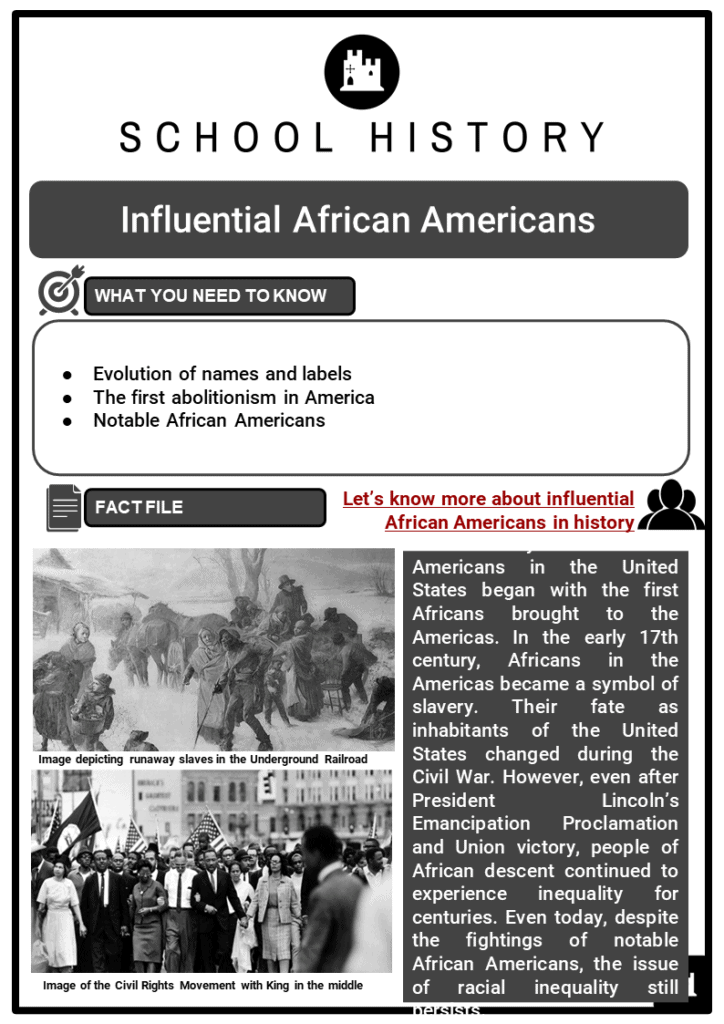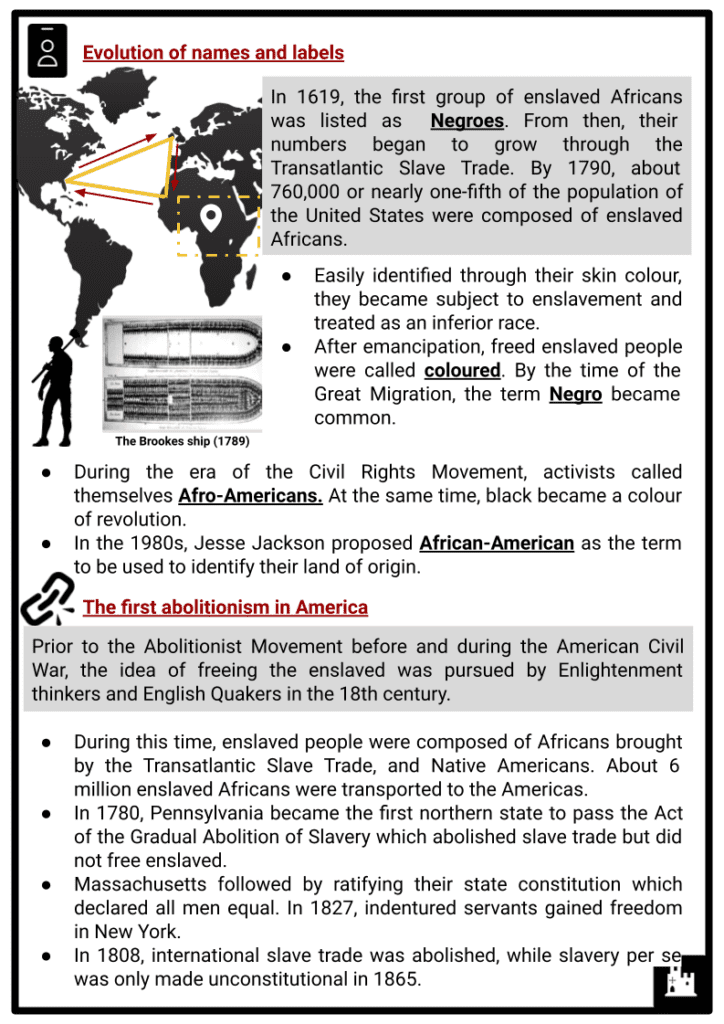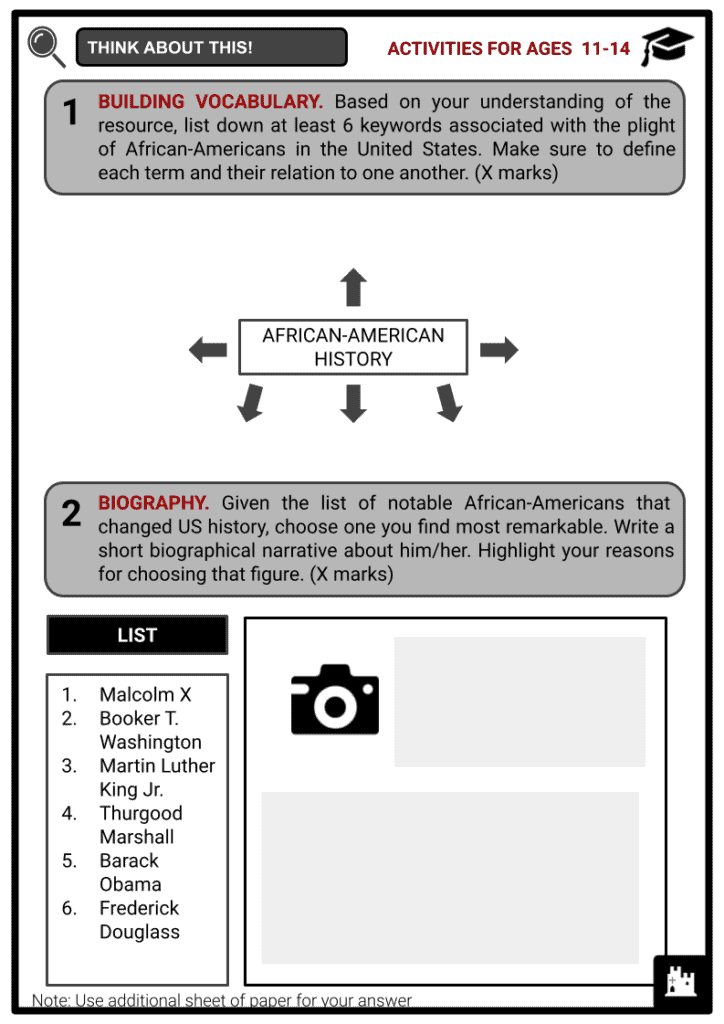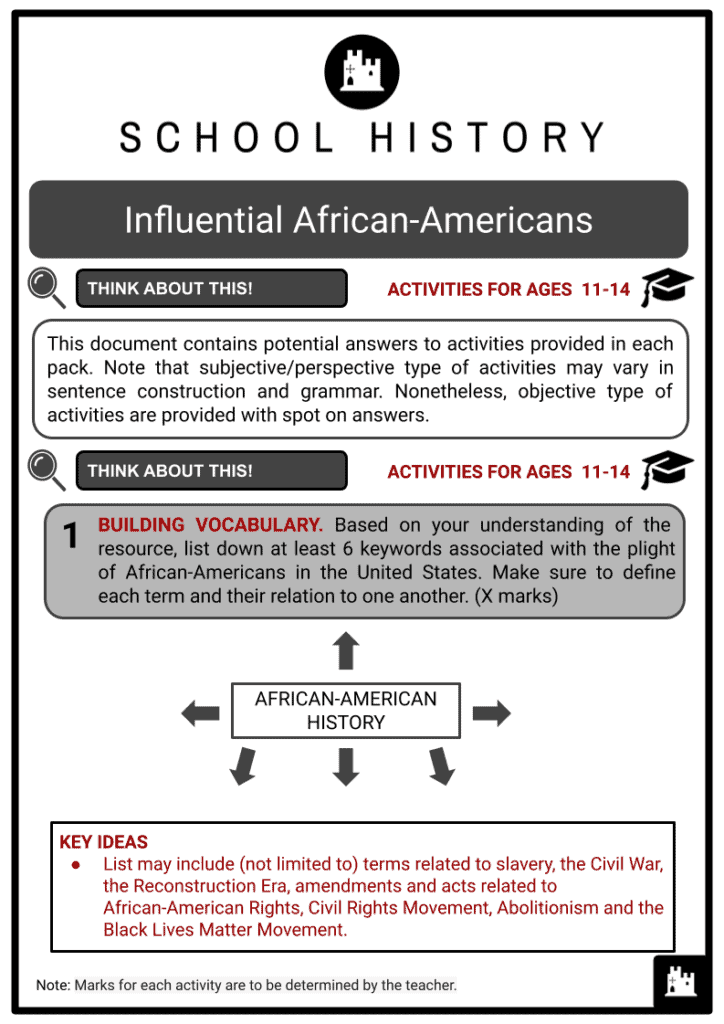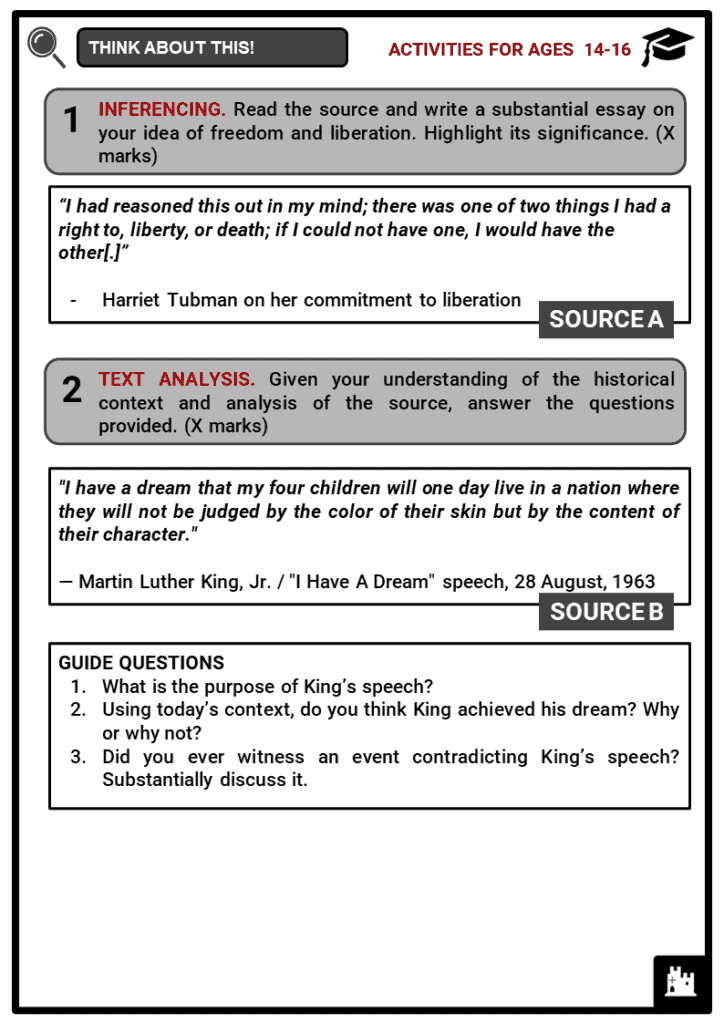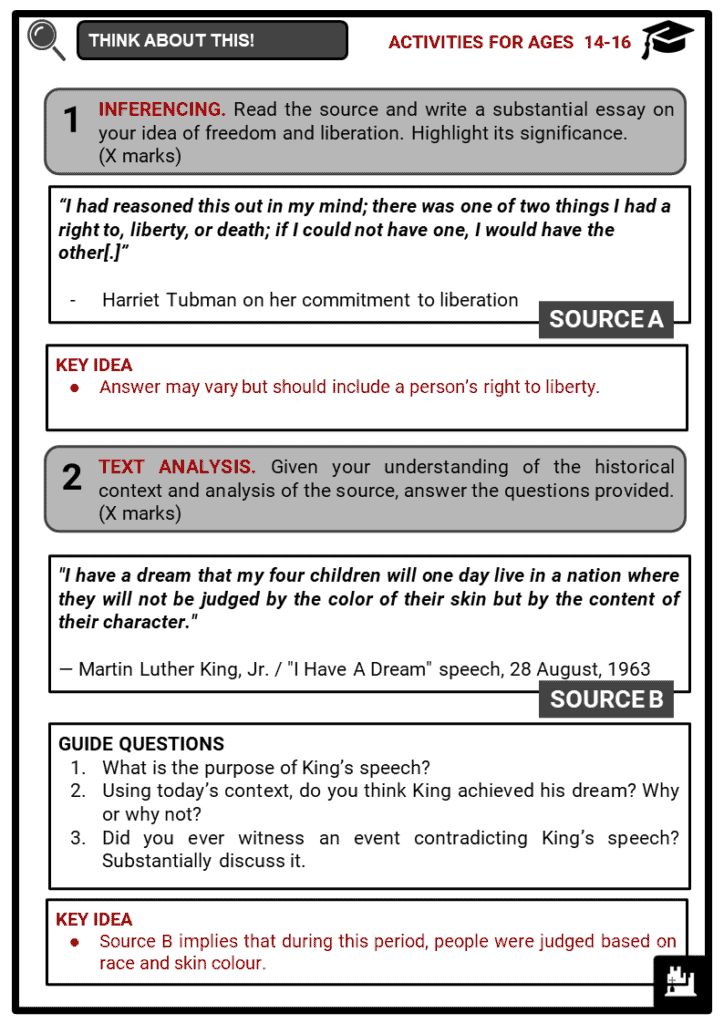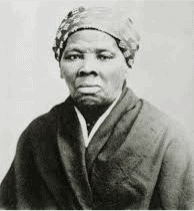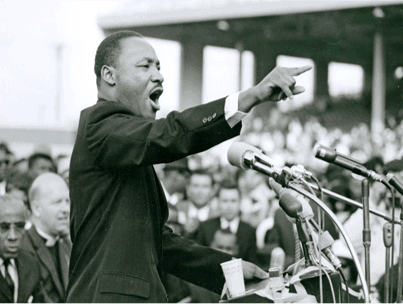Download Influential African-Americans Worksheets
Do you want to save dozens of hours in time? Get your evenings and weekends back? Be able to teach Influential African-Americans to your students?
Our worksheet bundle includes a fact file and printable worksheets and student activities. Perfect for both the classroom and homeschooling!
Table of Contents
Add a header to begin generating the table of contents
Summary
- Evolution of names and labels
- The first abolitionism in America
- Notable African-Americans
Key Facts And Information
Let’s know more about influential African-Americans in history!
- The history of African-Americans in the United States began with the first Africans brought to the Americas. In the early 17th century, Africans in the Americas became a symbol of slavery. Their fate as inhabitants of the United States changed during the Civil War. However, even after President Lincoln’s Emancipation Proclamation and Union victory, people of African descent continued to experience inequality for centuries. Even today, despite the fightings of notable African-Americans, the issue of racial inequality still persists.
Evolution of names and labels
- In 1619, the first group of enslaved Africans was listed as "negroes". From then, their numbers began to grow through the Transatlantic Slave Trade. By 1790, about 760,000, or nearly one-fifth of the population of the United States were composed of enslaved Africans.
- Easily identified through their skin colour, they became subject to enslavement and treated as an inferior race.
- After emancipation, freed enslaved people were called coloured. By the time of the Great Migration, the term Negro became common.
- During the era of the Civil Rights Movement, activists called themselves Afro-Americans. At the same time, black became a colour of revolution.
- In the 1980s, Jesse Jackson proposed African-American as the term to be used to identify their land of origin.
The first abolitionism in America
- Prior to the Abolitionist Movement before and during the American Civil War, the idea of freeing the enslaved was pursued by Enlightenment thinkers and English Quakers in the 18th century.
- During this time, enslaved people were composed of Africans brought by the Transatlantic Slave Trade, and Native Americans. About 6 million enslaved Africans were transported to the Americas.
- In 1780, Pennsylvania became the first northern state to pass the Act of the Gradual Abolition of Slavery which abolished slave trade but did not free the enslaved.
- Massachusetts followed by ratifying their state constitution, which declared all men equal. In 1827, indentured servants gained freedom in New York.
- In 1808, the international slave trade was abolished, while slavery per se was only made unconstitutional in 1865.
Notable African Americans
HARRIET TUBMAN
- A known conductor of the Underground Railroad who helped hundreds of escaping enslaved from the south. In 1849, Tubman escaped slavery herself in Philadelphia from Maryland. During the Civil War, she served as a nurse to Union soldiers.
- Born as Araminta Ross around 1822 in Maryland, she witnessed the violence caused by slavery. In 1849, she ran away to Pennsylvania but repeatedly went back to Maryland to rescue family and friends.
- Given the existing Fugitive Slave Act, which gave the right to arrest and return escaped enslaved people, Araminta, who was then married to John Tubman, risked her life to pursue liberty.
- Throughout her life, Tubman made about 13 trips to Maryland and helped nearly 70 runaways.
SOJOURNER TRUTH
- She became known for escaping slavery and her ‘Ain’t I a Woman’ speech during the Women’s Rights Convention held in 1851, in Ohio. Aside from being an abolitionist, Truth helped the Union in recruiting African-American troops, which greatly helped the north during the American Civil War.
- Born to enslaved parents in New York in 1797, Isabella was set free by Isaac Van Wagener. As as young girl, she joined the Retrenchment Society led by Elijah Pierson, a missionary.
- Isabella took the name Sojourner Truth in 1843 when she left New York to preach and attend camp meetings.
- In the same year, she became familiar with abolitionism in Northampton, Massachusetts.
- By the early 1850s, Truth became acquainted with women’s right activists such as Lucretia Mott.
- During the Civil War, she volunteered to support the black regiments.
- The idea of a women’s rights movement in America gained momentum during the Revolutionary War.
- In 1848, the Seneca Falls Convention took place in New York. Elizabeth Cady Stanton, a prominent women’s rights activist, presented the Declaration of Rights and Sentiments.
- Abolitionist Frederick Douglass and others who escaped slavery attended the convention.
- At the Women’s Rights Convention, Truth spoke about the rights of African-American women during and after the Civil War.
FREDERICK DOUGLASS
- He was a known abolitionist who befriended and influenced Lincoln in his view about African-Americans. Aside from supporting African-American equality, he also believed in the rights of women to suffrage.
- Born into slavery in Talbot County, Maryland, Frederick Washington Bailey learned to read and write from Sophia, wife of enslaver Hugh Auld.
- During this time, teaching enslaved people basic literature was prohibited. When Auld forbade Sophia from teaching, young Frederick did self-study by reading newspapers and learning from white children.
- He taught other enslaved people by reading the New Testament during church service.
- Douglass’ new enslaver William Freeland did not interfere with his teaching activities. However, other enslavers defied this activity. As a result, the congregation was dispersed permanently.
- At the age of 16, Douglass worked for Edward Covey who physically abused him. After their confrontation, Douglass attempted to escape. He succeeded the second time.
- In 1838, after his marriage to a formerly enslaved woman, Ann Murray, Douglass became an anti-slavery lecturer in New Bedford. At the Massachusetts Anti-Slavery Society’s annual convention, Douglass delivered his first speech.
- In 1845, his first autobiography was published. He set sail for Liverpool and Ireland to talk the about the evils of slavery. Douglass was known for the abolitionist papers The North Star, New National Era, Frederick Douglass Weekly and Douglass’ Monthly.
BOOKER T. WASHINGTON
- Despite being born into slavery, Washington was educated and denounced racism. With Du Bois, he established the NAACP in 1909. He was particularly known for accommodating white supremacy to uplift the African-American race.
- Born in Franklin County, Virginia in 1856, after the Civil War, Booker and his mother moved to West Virginia. His mother married a freedman, Washington Ferguson.
- Young Booker worked for Viola Ruffner who allowed him to study after two years of servitude.
- In 1872, out of hard work and intelligence, he was able to study at Hampton Normal Agricultural Institute in Virginia. Union General Samuel Armstrong was the headmaster who provided Booker with a scholarship and later became his mentor.
- After graduation in 1875, he became a teacher in Malden, Virginia. In 1881, General Armstrong recommended Booker to run the Tuskegee Normal and Industrial Institute (now Tuskegee University), a ‘coloured school’.
- In 1895, he delivered his speech, the Atlanta Compromise, at the Cotton States and International Exposition, which stated that African-Americans should accept social segregation as long as people of colour could access economic, legal and educational opportunities.
- This speech created tensions between Booker and W.E.B Du Bois, an African-American professor in Atlanta. Du Bois argued that Booker should demand equality as stipulated in the 14th Amendment.
- In 1901, Booker became the first African-American to dine with the president (Theodore Roosevelt) at the White House. Roosevelt and his successor, William Howard Taft sought Booker’s advice on racial matters.
- During his lifetime, he anonymously published five books: The Story of My Life and Work, Up from Slavery, The Story of the Negro: The Rise of the Race from Slavery, The Man Farthest Down and My Larger Education.
W.E.B DU BOIS
- A known writer, activist, and sociologist who co-founded the NAACP. In 1903, he wrote The Souls of Black Folk. Later in his life, he vocally opposed biological white superiority and supported women’s rights. Moreover, Du Bois proposed Pan-Africanism, which aimed to free African colonies from European control.
- Born in 1868, in Massachusetts, Du Bois grew up amongst a mostly white population. He attended school with white students and teachers.
- In 1885, he first encountered the Jim Crow Laws when he attended Fisk University in Tennessee.
- After his bachelor’s degree, he entered Harvard University. Under a scholarship, he attended the University of Berlin where he learned various political perspectives.
- In 1895, he became the first African-American to earn a PhD from Harvard University.
MALCOLM X
- Malcolm X was a minister of the Nation of Islam, and founder of Muhammad Speaks, the movement’s official newspaper. He believed in black pride, beauty and power. Following his break from the Nation of Islam in 1964 over ideological differences, he was assassinated in New York City.
- Born as Malcolm Little in 1925, in Nebraska, he was a son of a Baptist preacher and follower of Marcus Garvey. In 1931, his father was said to have been murdered by a white supremacist group.
- Due to economic instability, young Malcolm was sent to a foster home. At the age of 21, he was imprisoned for larceny. While in jail, he encountered Elijah Muhammad and the teachings of the Lost-Found Nation of Islam.
- He then adopted ‘X’ in his name to denounce slavery.
- After six years, Malcolm was freed from prison and became a minister at Mosque No. 7 in Harlem. By 1960, members of the Nation of Islam grew to 40,000 from 400 in 1952.
- Malcolm X’s advocacy was directly opposite to Martin Luther King’s nonviolent approach.
- In 1963, following John F. Kennedy’s assassination, Malcolm left the Nation of Islam due to corruption. The following year, after his pilgrimage to Mecca, he founded the Organization of Afro-American Unity which believed that racism per se was the enemy of justice.
MARTIN LUTHER KING JR.
- Martin Luther King Jr. was one of the key Civil Rights Movement leaders of his time. He attended several demonstrations, including the March on Washington, the Montgomery Bus Boycott, and the Selma to Montgomery March. In 1964, he received a Nobel Peace Prize. His assassination in 1968 produced developments in the fight against African-Americans in the US.
- Michael King Jr. was born on 15 January, 1929, in Georgia. King’s father adopted the name Martin Luther King Sr. in honour of the German Protestant religious reformer Martin Luther.
- In 1944, at the age of 15, he entered Morehouse College in Atlanta and earned a sociology degree after four years.
- In 1948, he attended Crozer Theological Seminary in Pennsylvania. By 1955, he earned his doctoral degree at Boston University, while being a pastor at Dexter Avenue Baptist Church of Montgomery in Alabama.
- In December 1955, upon the referral of E.D. Nixon, head of local NAACP chapter, King was elected to lead the Montgomery Bus Boycott. The boycott that involved harassment and intimidation of African-Americans in Montgomery lasted for 382 days.
- In 1957, King, other civil rights activists, and ministers founded the Southern Christian Leadership Conference to promote civil rights reforms in a nonviolent matter.
- Since its establishment, the SCLC sponsored mass meetings for black voting rights in southern states.
- On 28 August, 1963, King delivered his I Have a Dream speech at the March on Washington. Attended by more than 200,000 people, this event attracted both a national and international audience. The following year, President Lyndon B. Johnson signed the Civil Rights Act.
- On 9 March, 1965, another civil rights march was led by King to Edmund Pettus Bridge and attended by about 2,000 people. While Alabama Governor George Wallace restricted protests, President Johnson sent federal troops to protect the protestors.
- On 21 March, about 2,000 marchers began walking in Selma. After four days, the number grew to 25,000 in Montgomery where King delivered another televised speech. In the same year, President Johnson signed the Voting Rights Act.
- Both spiritual leaders and social activists, Malcolm X (1965) and King (1968) were assassinated. Malcolm X was murdered by members of the Nation of Islam (NOI), while King was killed by James Earl Ray.
- Decades after King’s assassination, his widow and children publicly announced their support of Ray (who admitted that he was only a fall guy and that a larger conspiracy plotted by the government was behind King’s assassination).
- After re-examination, the case was finally closed with the fact that Ray killed King.
THURGOOD MARSHALL
- Marshall became the first African-American to hold the Supreme Court Justice position. Prior to public office, he served as the NAACP’s lead attorney. He became known as ‘Mr. Civil Rights’ for being one of the pivotal figures who brought an end to the Jim Crow Laws.
- Born in 1908, in Baltimore, Maryland, Marshall studied at Baltimore’s Colored High and Training School.
- In 1926, he attended Lincoln University in Pennsylvania.
- In 1930, he applied to the University of Maryland Law School, but was rejected due to his race. As a result, he attended Howard University, a Black school in Washington D.C. After three years, he graduated magna cum laude.
- In 1934, Marshall started working for the National Association for the Advancement of Colored People (NAACP) Baltimore Branch.
- Marshall’s significant race-related cases include Murray v. Pearson (1936), Chambers v. Florida (1940), Smith v. Allwright (1944) and the Brown v. Board of education (1954).
- In 1961, JFK appointed him as judge for the US Second Circuit Court of Appeals. As Circuit court judge, he issued more than 100 decisions, all approved by the Supreme Court.
- In 1965, he was appointed as the first African-American solicitor general by President Johnson. Two years later, he was sworn in as the first African-American Supreme Court Justice. He joined the liberal faction of Chief Justice Earl Warren.
SHIRLEY CHISHOLM
- Chisholm was the first African-American woman to be elected to the US Congress. She served for seven terms between 1969 and 1983. In 1972, she became the first African-American candidate of a major party’s nomination for US President. Chisholm originated the slogan “Unbought and Unbossed.”
- Born in 1924, in Brooklyn, New York, Chisholm was a teacher. In 1946, she graduated from Brooklyn College and took her master’s degree at Columbia University.
- Between 1953 and 1959, she served as director of the Hamilton-Madison Child Care Center.
- Beginning in 1968, Chisholm served seven terms in the House of Representatives.
- In 1969, as one of the founding members of the Congressional Black Caucus, she pushed for minority education and employment.
- Chisholm made more history in 1972, when she became the first African-American to run for a major party nomination for the US Presidency. However, the Democratic nomination for presidency was won by South Dakota Senator George McGovern.
- In 1993, she was inducted into the National Women’s Hall of Fame for her contributions in the National Organization for Women (NOW) and NAACP, and political career, a rare profession for women during that time.
BARACK OBAMA
- Born in Hawaii to an American mother and Kenyan father, he was raised in Indonesia and worked in Chicago as a lawyer. In 2008, Obama became the 44th President of the United States and the first African-American to hold office. As president, he tamed the Great Recession and enacted reforms in healthcare that were previously debated for decades. Obama became known for his slogan, “Yes we can!”
- During the presidency of Obama, he persevered for equal economic opportunities for all Americans, including African Americans.
- Between 2014 and 2015, the median income of an African-American household increased by 4.1 percent and continued to grow until his last year in office.
- In the school year of 2013-2014, about 72.5% of African-Americans graduated from public high schools, the highest rate in American history.
OTHER INFLUENTIAL AFRICAN AMERICANS
- Robert Abbott, founder of The Chicago Defender
- Muhammad Ali, boxer, considered president of athletes and activist
- Ella Baker, backbone of the Civil Rights Movement
- Rosa Parks, activist who sparked the Montgomery Bus Boycott
- Aretha Franklin, singer-songwriter
- Jesse Jackson, politician and civil rights activist
- Michael Jackson, the ‘king of pop’ who became a cultural icon in the US
- Michael Jordan, basketball superstar
- Jesse Owens, track and field athlete who participated in the 1936 Olympics in Berlin
- Sidney Poitier, the first African-American actor and director to win an Academy Award
- Jackie Robinson, a baseball player and civil rights activist
- Madam C.J. Walker, entrepreneur and activist
- Ida B. Wells, journalist and activist who exposed post-Reconstruction violence against black communities
- Oprah Winfrey, a billionaire philanthropist and influential TV talk show host
Image sources:

